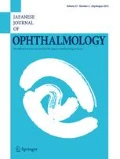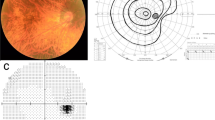Abstract
Purpose
To evaluate the relationship between peripapillary tilt and visual field (VF) defects in glaucomatous eyes with axial myopia.
Study design
Retrospective cross-sectional study.
Patients and methods
One hundred four eyes of 104 patients with primary open-angle glaucoma (POAG) with myopia were included (52 eyes with high myopia [HM], 26.5 mm ≤ axial length [AL] < 30.0 mm; and 52 eyes without HM, 24.0 mm < AL < 26.5 mm). The direction and magnitude of the peripapillary tilt were evaluated using optical coherence tomography. The eyes were divided into 12 groups according to the tilt directions defined by clock-hour sectors in a clockwise direction in the right eyes and in a counterclockwise direction in the left eyes. The mean deviation (MD) and central VF (CVF) values, ie, the mean threshold values of 4 paracentral points within 5 degrees of the Swedish Interactive Threshold Algorithm 30–2 test, were evaluated.
Results
The direction of the tilt was toward sector 9 (47.1%) and sector 8 (34.6%). The MD and CVF values were significantly worse (P = 0.013 and P = 0.019, respectively) in the sector 9 group than in the sector 8 group. Furthermore, the smaller peripapillary tilt magnitude in the sector 9 group was negatively correlated (P = 0.0019) with the CVF but not with the MD (P = 0.1) among the POAG eyes with HM. In contrast, the ovality index in the sector 9 group was not significantly correlated with the MD (P = 0.4) or the CVF (P = 0.36).
Conclusion
A smaller temporal peripapillary tilt correlated with CVF defects in POAG eyes with HM. The peripapillary tilt direction and magnitude affect the CVF defect in POAG eyes with HM.





Similar content being viewed by others
References
Iwase A, Suzuki Y, Araie M, Yamamoto T, Abe H, Shirato S, Tajimi Study Group. Japan Glaucoma Society, et al. The prevalence of primary open-angle glaucoma in Japanese: the Tajimi Study. Ophthalmology. 2004;111:1641–8.
Flammer J, Orgül S. Optic nerve blood-flow abnormalities in glaucoma. Prog Retin Res. 1998;17:267–89.
Sung KR, Lee S, Park SB, Choi J, Kim ST, Yun SC, et al. Twenty-four hour ocular perfusion pressure fluctuation and risk of normal-tension glaucoma progression. Invest Ophthalmol Vis Sci. 2009;50:5266–74.
Ren R, Jonas JB, Tian G, Zhen Y, Ma K, Li S, et al. Cerebrospinal fluid pressure in glaucoma: a prospective study. Ophthalmology. 2010;117:259–66.
Xu L, Wang Y, Wang S, Wang Y, Jonas JB. High myopia and glaucoma susceptibility: the Beijing Eye Study. Ophthalmology. 2007;114:216–20.
Suzuki Y, Iwase A, Araie M, Yamamoto T, Abe H, Shirato S, et al. Risk factors for open-angle glaucoma in a Japanese population: the Tajimi Study. Ophthalmology. 2006;113:1613–7.
Oku Y, Oku H, Park M, Hayashi K, Takahashi H, Shouji T, et al. Long axial length as risk factor for normal tension glaucoma. Graefes Arch Clin Exp Ophthalmol. 2009;247:781–7.
Kimura Y, Hangai M, Morooka S, Takayama K, Nakano N, Nukada M, et al. Retinal nerve fiber layer defects in highly myopic eyes with early glaucoma. Am J Ophthalmol. 2013;155:927–36.
Chihara E, Tanihara H. Parameters associated with papillomacular bundle defects in glaucoma. Graefes Arch Clin Exp Ophthalmol. 1992;230:511–7.
Nakazawa T, Fuse N, Omodaka K, Aizawa N, Kuwahara S, Nishida K. Different types of optic disc shape in patients with advanced glaucoma. Jpn J Ophthalmol. 2010;54:291–5.
Kimura Y, Akagi T, Hangai M, Takayama K, Hasegawa T, Suda K, et al. Lamina cribrosa defects and optic disc morphology in primary open angle glaucoma with high myopia. PLoS ONE. 2014;9:e115313.
Miki A, Ikuno Y, Asai T, Usui S, Nishida K. Defects of the lamina cribrosa in high myopia and glaucoma. PLoS ONE. 2015;10:e0137909.
Han JC, Cho SH, Sohn DY, Kee C. The characteristics of lamina cribrosa defects in myopic eyes with and without open-angle glaucoma. Invest Ophthalmol Vis Sci. 2016;57:486–94.
Sawada Y, Araie M, Ishikawa M, Yoshitomi T. Multiple temporal lamina cribrosa defects in myopic eyes with glaucoma and their association with visual field defects. Ophthalmology. 2017;124:1600–11.
Takayama K, Hangai M, Kimura Y, Morooka S, Nukada M, Akagi T, et al. Three-dimensional imaging of lamina cribrosa defects in glaucoma using swept-source optical coherence tomography. Invest Ophthalmol Vis Sci. 2013;54:4798–807.
Hosseini H, Nassiri N, Azarbod P, Giaconi J, Chou T, Caprioli J, et al. Measurement of the optic disc vertical tilt angle with spectral-domain optical coherence tomography and influencing factors. Am J Ophthalmol. 2013;156:737–44.
Shoji T, Kuroda H, Suzuki M, Ibuki H, Araie M, Yoneya S. Vertical asymmetry of lamina cribrosa tilt angles using wide bandwidth, femtosecond mode-locked laser OCT: effect of myopia and glaucoma. Graefes Arch Clin Exp Ophthalmol. 2017;255:197–205.
Lee JE, Sung KR, Lee JY, Park JM. Implications of optic disc tilt in the progression of primary open-angle glaucoma. Invest Ophthalmol Vis Sci. 2015;56:6925–31.
Lee JY, Sung KR, Han S, Na JH. Effect of myopia on the progression of primary open-angle glaucoma. Invest Ophthalmol Vis Sci. 2015;56:1775–811.
Sung MS, Kang YS, Heo H, Park SW. Optic disc rotation as a clue for predicting visual field progression in myopic normal-tension glaucoma. Ophthalmology. 2016;123:1484–93.
Asai T, Ikuno Y, Akiba M, Kikawa T, Usui S, Nishida K. Analysis of peripapillary geometric characters in high myopia using swept-source optical coherence tomography. Invest Ophthalmol Vis Sci. 2016;57:137–44.
Littmann H. Determination of the real size of an object on the fundus of the living eye [in German]. Klin Monbl Augenheilkd. 1982;180:286–9.
Tay E, Seah SK, Chan SP, Lim AT, Chew SJ, Foster PJ, et al. Optic disk ovality as an index of tilt and its relationship to myopia and perimetry. Am J Ophthalmol. 2005;139:247–52.
Kim TW, Kim M, Weinreb RN, Woo SJ, Park KH, Hwang JM. Optic disc change with incipient myopia of childhood. Ophthalmology. 2012;119:21–6.
Park HY, Lee K, Park CK. Optic disc torsion direction predicts the location of glaucomatous damage in normal-tension glaucoma patients with myopia. Ophthalmology. 2012;119:1844–51.
Takasaki H, Higashide T, Takeda H, Ohkubo S, Sugiyama K. Relationship between optic disc ovality and horizontal disc tilt in normal young subjects. Jpn J Ophthalmol. 2013;57:34–40.
Choi JA, Park HY, Shin HY, Park CK. Optic disc tilt direction determines the location of initial glaucomatous damage. Invest Ophthalmol Vis Sci. 2014;55:4991–8.
Teng CC, De Moraes CG, Prata TS, Tello C, Ritch R, Liebmann JM. Beta-zone parapapillary atrophy and the velocity of glaucoma progression. Ophthalmology. 2010;117:909–15.
Kawano J, Tomidokoro A, Mayama C, Kunimatsu S, Tomita G, Araie M. Correlation between hemifield visual field damage and corresponding parapapillary atrophy in normal-tension glaucoma. Am J Ophthalmol. 2006;142:40–5.
Xu L, Wang Y, Yang H, Jonas JB. Differences in parapapillary atrophy between glaucomatous and normal eyes: the Beijing Eye Study. Am J Ophthalmol. 2007;144:541–6.
Hayashi K, Tomidokoro A, Lee KY, Konno S, Saito H, Mayama C, et al. Spectral-domain optical coherence tomography of β-zone peripapillary atrophy: influence of myopia and glaucoma. Invest Ophthalmol Vis Sci. 2012;53:1499–505.
Kim M, Kim TW, Weinreb RN, Lee EJ. Differentiation of parapapillary atrophy using spectral-domain optical coherence tomography. Ophthalmology. 2013;120:1790–7.
Jonas JB, Kling F, Grundler AE. Optic disc shape, corneal astigmatism and amblyopia. Ophthalmology. 1997;104:1934–7.
Lee KM, Lee EJ, Kim TW. Lamina cribrosa configuration in tilted optic discs with different tilt axes: a new hypothesis regarding optic disc tilt and torsion. Invest Ophthalmol Vis Sci. 2015;56:2958–67.
Yamashita T, Sakamoto T, Yoshihara N, Terasaki H, Kii Y, Tanaka M, et al. Circumpapillary course of retinal pigment epithelium can be fit to sine wave and amplitude of sine wave is significantly correlated with ovality ratio of optic disc. PLoS ONE. 2015;10:e0122191.
Kim YC, Jung Y, Park HL, Park CK. The location of the deepest point of the eyeball determines the optic disc configuration. Sci Rep. 2017;7:5881.
Moriyama M, Ohno-Matsui K, Hayashi K, Shimada N, Yoshida T, Tokoro T, et al. Topographic analyses of shape of eyes with pathologic myopia by high-resolution three-dimensional magnetic resonance imaging. Ophthalmology. 2011;118:1626–37.
Ohno-Matsui K, Akiba M, Modegi T, Tomita M, Ishibashi T, Tokoro T, et al. Association between shape of sclera and myopic retinochoroidal lesions in patients with pathologic myopia. Invest Ophthalmol Vis Sci. 2012;53:6046–61.
Akagi T, Hangai M, Kimura Y, Ikeda HO, Nonaka A, Matsumoto A, et al. Peripapillary scleral deformation and retinal nerve fiber damage in high myopia assessed with swept-source optical coherence tomography. Am J Ophthalmol. 2013;155:927–36.
Author information
Authors and Affiliations
Corresponding author
Ethics declarations
Conflicts of interest
S. Usui, None; Y. Ikuno, None; T. Asai, None; T. Kikawa, Employee (Topcon); M. Akiba, Employee (Topcon); A. Miki, Honorarium (Santen, Pfizer, Kowa, Otsuka, Alcon, Topcon, Novartis, HOYA, Ellex, JFC, Senju); K. Matsushita, Lecture fee(Alcon, Kowa, Nitten, Otsuka, Pfizer, Santen, Senju), Lecture fee, Advisory fee (Maruho);R. Kawasaki, Endowed Department Chair (Topcon), Grant (Senju, Novartis, Pfizer), Advisory fee (Office Future, Predictive Analytics, MICIN); K. Nishida, Grant (Topcon).
Additional information
Publisher's Note
Springer Nature remains neutral with regard to jurisdictional claims in published maps and institutional affiliations.
Corresponding Author: Shinichi Usui
Electronic supplementary material
Below is the link to the electronic supplementary material.
About this article
Cite this article
Usui, S., Ikuno, Y., Asai, T. et al. Effect of peripapillary tilt direction and magnitude on central visual field defects in primary open-angle glaucoma with high myopia. Jpn J Ophthalmol 64, 414–422 (2020). https://doi.org/10.1007/s10384-020-00747-y
Received:
Accepted:
Published:
Issue Date:
DOI: https://doi.org/10.1007/s10384-020-00747-y




